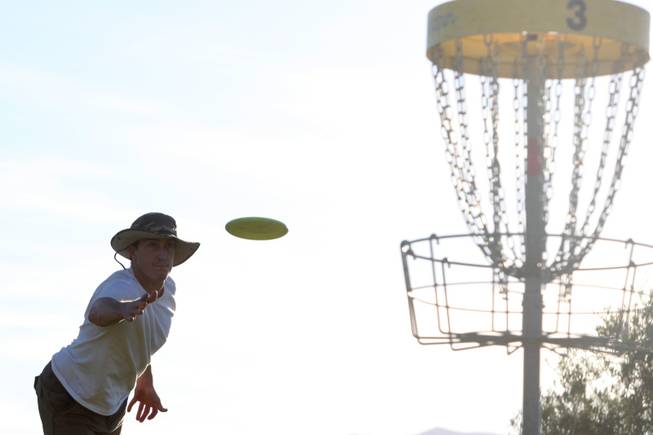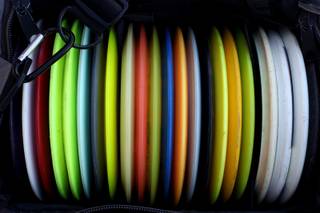
Las Vegas Disc Golf Club member Shadd Wade putts Thursday, June 4, 2010 during the weekly event held at Mountain Crest Park in Las Vegas.
Saturday, June 5, 2010 | 2:01 a.m.
Where to play
Disc golf is free to play. Just like pickup basketball, simply arrive at your neighborhood park with a disc and start playing. There are six courses in Southern Nevada — Sunset Park,
Freedom Park, Hampton Park and
Peccole Ranch Park (private for residents of that community). Visit
lvbagtag.com for information on how to join the Las Vegas Disc Golf Club. For a membership fee of $15 to $60 you get to everything from discounts into tournaments and equipment. Several also compete nationally in the
Course makeup
Each hole is a par 3 and roughly 350 to 450 feet in distance and ends with a 5-foot-high metal basket or cage anchored to a pole.
With a brisk breeze at his back, John Ricker stands at the tee box analyzing how to best attack the hole.
Ricker sees nothing but perfectly manicured green grass at Mountain Crest Park standing between him and the hole 400 feet away.
He is stoic in concentration. The other three competitors in his group are equally silent so as not to disrupt.
Welcome to the Thursday night doubles social, promoted by the Las Vegas Disc Golf Club.
Disc golf uses some of the same etiquette and strategy as traditional golf, which disc players refer to as “ball” or “stick golf.”
Stick golfers carry around a bag of clubs. The 49-year-old Ricker reaches into his duffle-sized disc bag, grabbing one of a dozen discs. He launches a low shot, avoiding the wind gust and landing about 40 feet from the hole, or target — a metal basket or cage on a pole and about 5 feet high.
“At the end of the day, that’s a great shot,” said Ricker, the club’s president. “There is a lot of thinking that goes into this. You just don’t take a run and throw.”
The disc, which weighs roughly 200 grams (about a half-pound) and is about 10 inches across depending on the model, is hard to track on this windy outing. Players commonly yell “Fore!” to warn pedestrians of potential danger.
Part of mastering the game, which has grown in popularity, is picking the correct disc to throw. A flatter disc, for instance, is typically used for short-range shots.
“These are our clubs,” Ricker said. “Some of these bad boys are made to fly.”
The club has 160 members and courses can be found at six Southern Nevada parks. Previously, Sunset Park — the Augusta National of local disc courses — had the area’s lone disc facility.
Players say they prefer this form of golf because it is more economical. Discs cost as little as $20, membership in the local club is $15 to $60 annually and each round is a few dollars. The fee for Thursday’s social is $7 — $1 for a hole-in-one jackpot, $1 for a fund to replace targets (about six of the $400 cages are stolen each year) and $5 toward nightly payouts for the top finishing pairs.
The group hosts doubles, or pairs, nights Tuesdays, Wednesdays and Thursdays, using best-disc format where two-man teams are selected by draw using playing cards. Single games are mostly played on the weekends and in tournaments.
Several compete in regional and national events, which require membership in the Professional Disc Golf Association. The club will host the Halloween Classic in late October, with Ricker receiving several calls of interest this week from out-of-state competitors in the days after posting a notice on the website.
“It’s addictive as hell. It’s fun as hell to watch it fly,” said Matt Alexander, the club’s director. “This is my release. I work a million hours a week and this helps me relax.”
Every hole is a par 3 and roughly 350 to 450 feet in distance, with the top competitors easily clearing 300 feet on their initial throws. That puts a premium on putting, with several accurate from 20 feet out, and the elite players nationally able to connect from 40 feet on a consistent basis.
“There is a saying that you drive for show and putt for dough,” said Steve Berger, 26, who has been playing for seven years.
Like traditional golf, the courses each have a distinct personality. The layout at Mountain Crest is 18 holes and relatively short, placing value on accuracy. At Sunset Park, it is 24 holes and long, giving players with big throws an edge.
“Mountain Crest is not as forgiving as Sunset,” Alexander said. “People who do well at Sunset can’t adjust out here.”
The club participants reflect different walks of life — Alexander works in sales, Ricker is an information technology specialist and another golfer is a lawyer. But there is one group of people missing: women.
Of the 36 who competed in Thursday night’s social, none was female. Also, few children are involved.
Ricker and other board members are reaching out to both groups, hosting social nights for wives and girlfriends, and donating starter discs to children who they run into at the park.
Shadd Wade, 32, started playing in Colorado Springs, Colo., during his teens. He quickly found disc golf is a life sport, something he’s been playing in various cities until settling in Las Vegas two years ago.
“All you need is $10 and a couple of hours,” Wade said. “There are no tee times or $500 clubs.”
But at first, like most players, learning the sport took patience. There was a period of adversity that proved to be frustrating.
“I was awful. I just hated this,” he said.
Now, he is a regular in analyzing each shot and watching his disc take off in the wind.


Join the Discussion:
Check this out for a full explanation of our conversion to the LiveFyre commenting system and instructions on how to sign up for an account.
Full comments policy